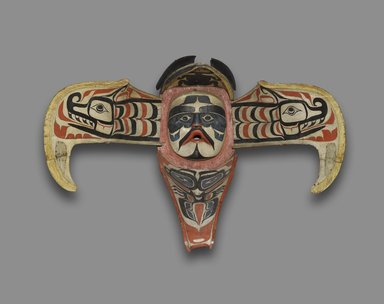
Artist:NamgisKwakwaka'wakw
Medium: Cedar, pigment, leather, nails, metal plate
Geograhical Locations:
Dates:19th century
Dimensions: Open: 31 x 45 x 47 in. (78.7 x 114.3 x 119.4 cm) Closed: 20 1/2 x 17 x 29 1/2 in. (52.1 x 43.2 x 74.9 cm) 7/2012 new measurements when opened, 47" out from wall, 45" wide, 31 " height
Collections:
Museum Location: American Art Galleries, 5th Floor, Witness
Exhibitions:
Accession Number: 08.491.8902
Image: 08.491.8902_front_PS6.jpg,
Catalogue Description: Transformation masks such as this Thunderbird belong to the sky world, which consists of Ancestral Beings that are transported to the heavens from where they can return as material beings in recognizable form such as human. The Kwakwaka’ wakw people say when this bird ruffles its feathers they cause thunder and when they blink their eyes lightning flashes. Each thunderbird is associated with a specific village group or lineage, a specific place of origin unique to each and its details are carefully guarded. Masks can be owned individually or by a family but rights are always inherent, flowing from one generation to the next. The Namgis people relate that this thunderbird flew out of the heavens to assist a man who had transformed into a large halibut. When finished assisting he removed his headdress and winged cape and sent them back to the sky world becoming human. The mask may be worn on the forehead with the dancer’s face showing or it may cover the face to indicate the duality of man and bird. The performer wears a full costume of representing the bird. The mask would be danced during a Winter Ceremony, called a Potlatch, where songs, dances and rituals are performed and gifts may be given. When not used such masks are wrapped carefully and hidden away. When worn and danced and closed the mask portrays a bird head with a large yellow beak. When open, the head and large beak divide, expand, and become a full-bodied bird with outstretched wings. Each wing contains a linear image of a sisiutl or lightning snake. At the center of the full-bodied bird is a human head. Above the head is a small seated figure and below it is still another bird. Opening and closing the mask would add a spectacular effect during the dances. When the mask was first collected it had cord riggings to open its parts. It was collected from the Gigilgam lineage of the Nimpkish. The mask is fragile but stable. There are scattered pigment losses. Red cedar ruff originally surrounded the mask when it was worn for performances.